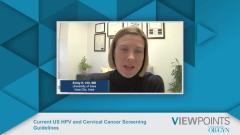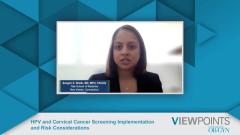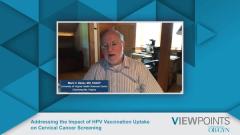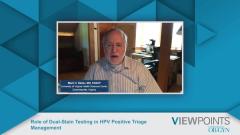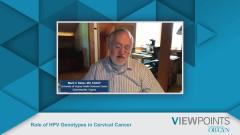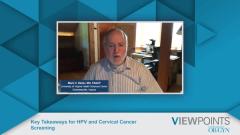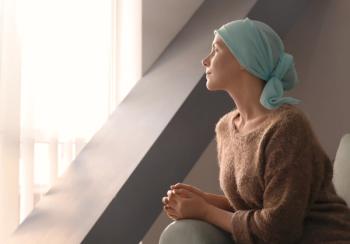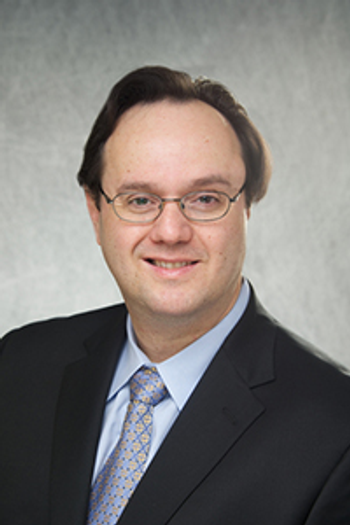
Current US HPV and Cervical Cancer Screening Guidelines
Emily K. Hill, MD, reviews the current US HPV and cervical cancer screening guidelines from the American Cancer Society, American College of Obstetricians and Gynecologists, and the American Society for Colposcopy and Cervical Pathology and discusses the differences within.
Episodes in this series

Dr Thomas C Wright Jr: Dr Hill, what are the current US guidelines? We now have some discrepancies. You've got a set from the American Cancer Society, which are not very long ago and now we have the ASCCP which joined together with the ACOG and SGO to come up with another set of guidelines. What are the differences?
Dr Emily K. Hill: I think these do frankly get confusing for people because there are different sets, and some of the recommendations have similarities, and there are some differences, and sometimes it's hard to tease that out. I feel for myself, especially when I'm teaching learners that there's constantly a new evolution of this, which is appropriate, that it'd be updated and recommendations and data changes. In my lectures, I almost never put actual specifics, especially with medical students because it changes so much. I think one of the big differences is that the American Cancer Society guidelines really embrace that primary HPV screening as a preferred option. They have no screening actually up until the age of 25 with screening starting at 25, which is later than the ASCCP guidelines which still recommend starting at 21 for pap screening. With the American Cancer Society, again, you're starting at 25, and it's really primary HPV screening alone as the preferred option for women after that age of 25, whereas the ASCCP guidelines have the 21 to 29 year old age group still cytology alone, done every 3 years, I believe. Hopefully, I'm not getting them wrong myself.
Dr Thomas C Wright Jr: It's every 3.
Dr Emily K. Hill: Then basically at 30, it's starting to do the co-testing with HPV and cytology. I think the reason for that is the prevalence of the frequency of high-risk HPV being a lot higher in that younger age group, but they are less likely to actually develop precancer and cancer. I think that's the big difference. It is a pretty big difference, and as a provider, you have to pick which guideline you're gonna go with. Again, some of that right now might be your availability of primary HPV screening, but I think part of it also is it's just a change in our practice, and I think patients struggle with it too because they're told for years, get your pap every year; this pap is super important. Then the transition to a screening system where you're either not having Pap until you're 25 or you're only doing HPV screening can be hard for patients too, and explaining that to patients and reassuring them that it's a safe approach takes some finesse.
Dr Thomas C Wright Jr: Now, you were part of the ASCCP committees which developed the joint or which adopted the guideline with the SGO and ACOG. The ASCCP really adopted the previous US Preventative Services guidelines. What were the discussions around not doing HPV primary screening in women 25 to 30 or 29?
Dr Emily K. Hill: It's not that they don't support those American Cancer Society guidelines because there is support, I think, in general endorsement that they're a reasonable, acceptable screening strategy. I think one of the big things was just implementation issues, worrying that if we went right to that as the clearly preferred method, but it's not available to the majority of providers in the US. That is problematic, and there's just so much that has to change in FDA approval of primary HPV screening tests being widely available, cost, workflow, billing, insurances. There's just a lot of complexity there. I think the lack of uptake in HPV vaccination in our US population is problematic too because, again, if you're using primary HPV screening for this younger age group, you're gonna get a lot of positive tests, and you have to figure out the negatives to that of which there are several. I think the hope being that in 5 years or a few years, shouldn't put a number on it that maybe we'll have better vaccination rates, so the younger women moving forward will have higher protection from that reason. Then the age of HPV screenings becomes a little, I don’t know if easier is the right word. Then I think the other concern is that a lot of the studies that have been done did not necessarily have great representation from some underserved and minority populations in the US, so there is concern about different HPV strains in different groups of women and that potentially some of the data on the primary HPV screening hasn't properly extended to those patients or those women. There is some concerns about that. I think all of that weighed into the choice to support the US Preventative Services guidelines for now.
TRANSCRIPT EDITED FOR CLARITY
Newsletter
Get the latest clinical updates, case studies, and expert commentary in obstetric and gynecologic care. Sign up now to stay informed.



